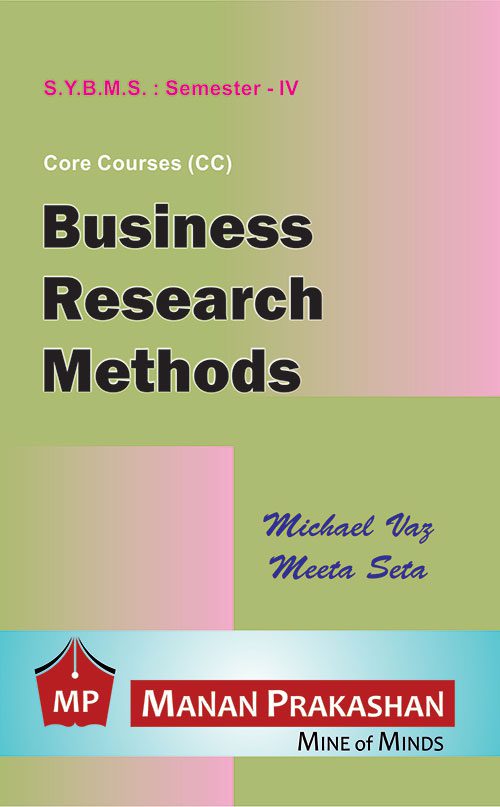Business Research Methods SYBMS Semester IV Manan Prakashan
Core Courses (CC)
Content:
Unit – I : Introduction to Business Research Methods (18 Lec.)
1. Meaning and Objectives of Research
2. Types of Research – (a) Pure, Basic and Fundamental (b) Applied (c) Empirical (d) Scientific & Social (e) Historical (f) Exploratory (g) Descriptive (h) Causal
3. Concepts in Research: Variables, Qualitative and Quantitative Research
4. Stages in Research Process
5. Characteristics of Good Research
6. Hypothesis – Meaning, Nature, Significance, Types of Hypothesis, Sources
7. Research Design – Meaning, Definition, Need and Importance, Steps in Research Design, Essentials of a Good Research Design, Areas/Scope of Research Design and Types – Descriptive, Exploratory and Causal
8. Sampling – (a) Meaning of Sample and Sampling, (b) Methods of Sampling – (i) Non Probability Sampling – Convenient, Judgement, Quota, Snow ball (ii) Probability – Simple Random, Stratified, Cluster, Multi Stage.
Unit – I : Introduction to Business Research Methods (18 Lec.)
1. Meaning and Objectives of Research
2. Types of Research – (a) Pure, Basic and Fundamental (b) Applied (c) Empirical (d) Scientific & Social (e) Historical (f) Exploratory (g) Descriptive (h) Causal
3. Concepts in Research: Variables, Qualitative and Quantitative Research
4. Stages in Research Process
5. Characteristics of Good Research
6. Hypothesis – Meaning, Nature, Significance, Types of Hypothesis, Sources
7. Research Design – Meaning, Definition, Need and Importance, Steps in Research Design, Essentials of a Good Research Design, Areas/Scope of Research Design and Types – Descriptive, Exploratory and Causal
8. Sampling – (a) Meaning of Sample and Sampling, (b) Methods of Sampling – (i) Non Probability Sampling – Convenient, Judgement, Quota, Snow ball (ii) Probability – Simple Random, Stratified, Cluster, Multi Stage.
Unit – 2 : Data Collection and Processing (14 Lec.)
1. Types of Data and Sources – Primary and Secondary Data Sources
2. Methods of collection of primary data
(a) Observation – (i) structured and unstructured, (ii) disguised and undisguised, (iii) mechanical observations (use of gadgets)
(b) Experimental – (i) Field, (ii) Laboratory
(c) Interview – (i) Personal Interview, (ii) focused group, (iii) indepth interviews – Method
(d) Survey – Telephonic survey, Mail, E-mail, Internet survey, Social Media, and Media Listening
(e) Survey Instrument – (i) Questionnaire designing, (ii) Types of questions – (a) structured/ close ended and (b) unstructured/ open ended, (c) Dicotomous, (d) Multiple Choice Questions
(f) Scaling techniques – (i) Likert scale, (ii) Semantic Differential scale
1. Types of Data and Sources – Primary and Secondary Data Sources
2. Methods of collection of primary data
(a) Observation – (i) structured and unstructured, (ii) disguised and undisguised, (iii) mechanical observations (use of gadgets)
(b) Experimental – (i) Field, (ii) Laboratory
(c) Interview – (i) Personal Interview, (ii) focused group, (iii) indepth interviews – Method
(d) Survey – Telephonic survey, Mail, E-mail, Internet survey, Social Media, and Media Listening
(e) Survey Instrument – (i) Questionnaire designing, (ii) Types of questions – (a) structured/ close ended and (b) unstructured/ open ended, (c) Dicotomous, (d) Multiple Choice Questions
(f) Scaling techniques – (i) Likert scale, (ii) Semantic Differential scale
Unit – 3 : Data Analysis and Interpretation (16 Lec.)
(a) Processing of data – i) Editing – field and office editing, ii) coding – meaning and essentials, iii) tabulation – note
(b) Analysis of data- Meaning, Purpose, types.
(c) Interpretation of data- Essentials, importance and Significance of processing data
(d) Multivariate analysis – concept only
(e) Testing of hypothesis – concept and problems – (i) chi square test, (ii) Z and t-test (for large and small sample)
(a) Processing of data – i) Editing – field and office editing, ii) coding – meaning and essentials, iii) tabulation – note
(b) Analysis of data- Meaning, Purpose, types.
(c) Interpretation of data- Essentials, importance and Significance of processing data
(d) Multivariate analysis – concept only
(e) Testing of hypothesis – concept and problems – (i) chi square test, (ii) Z and t-test (for large and small sample)
Unit – 4 : Advanced Techniques in Report Writing (12 Lec.)
1. Report Writing – (i) Meaning, Importance, Functions of Reports, Essential of a Good Report, Content of Report, Steps in writing a Report, Types of Reports, Footnotes and Bibliography
2. Ethics and Research
3. Objectivity, Confidentiality, and Anonymity in Research
4. Plagiarism
1. Report Writing – (i) Meaning, Importance, Functions of Reports, Essential of a Good Report, Content of Report, Steps in writing a Report, Types of Reports, Footnotes and Bibliography
2. Ethics and Research
3. Objectivity, Confidentiality, and Anonymity in Research
4. Plagiarism
Additional Information
| BOARD | Mumbai University |
|---|---|
| ISBN-13 | 978-93-89293-22-7 |
| AUTHOR | Michael Vaz and Meeta Seta |
| PUBLISHER | Manan Prakashan |
| ED | All |
| PAGES | 216 |
| SUBJECT | Business Research Methods SYBMS Semester IV |
| LANGUAGE | English |


Reviews
There are no reviews yet.